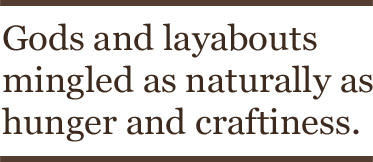The traveler, I decided one day, is part photographer and part philosopher: His aim, as he sets out, is to catch some aspect of his subject—a tilt of head, a glint of eye—that exists out of time, and so to show us, as a portrait-painter might once have done, that aspect of a place that was there when he was 8 and will be there when he is 80; and yet his deeper purpose, what elevates his mission, and makes it more worthwhile, is to take his subject out of space, too, to explore those larger questions every place dramatizes and that apply to almost everyone. A travel writer is, to some degree, Cartier-Bresson roaming around the global or local neighborhood with a book of theology in his hand. (Cartier-Bresson himself once confessed to being “an accidental Buddhist.”)
All travelers exist at some point along this continuum: Jan Morris, say, is a master impressionist, whose instincts for place are so sure and so well-trained that she can walk around a city, taking in details and weaving them into a tapestry that seems to catch even the invisible features of her subject, indelibly (what lies behind its gestures and disguises). Other travelers, more haunted, carry questions, not answers or explanations, around with them wherever they go, and look to everywhere to give them some understanding, or even movement towards resolution, of the issue that is their lifelong companion (V.S. Naipaul is the archetype of this). A Morris can and will write about everywhere, much as an interviewer may summon someone to her room and assess her expertly within a few minutes; a Naipaul returns over and over to the same few places, and they are always the places that he feels can unlock one particular aspect of his circumstance—in his case, the attempt to find a voice after a colonial upbringing, how truly to come upon a state of independence.
The rest of us generally situate ourselves somewhere between the two extremes, or, as we go on through life, or as our command of places goes deeper, move from one towards the other. Paul Theroux, you could say, has attitude, though this does not make him a philosopher, while Ryszard Kapuscinski found scenes so archetypal that they offered up parables and a W.G. Sebald wrote of nothing but a philosophical restlessness, a hauntedness that pricked him daily and drew blood. And the nature of a traveler, of course, is to be constantly changing forms. Jan Morris’s last book, “Trieste and the Meaning of Nowhere,” surrounds us with exquisite details and historical curiosities and agile impressions of Trieste, in her usual manner, but, touchingly, and piercingly, flowing from a soul in its mid-70s, comes to ask questions about the traveler who finds herself reflected in the place; Naipaul, too, was more content with sensual observation when young and, though he has taken himself severely out of his portraits in recent years, has never eliminated the silent, throbbing questioningness that lies behind them.
When Morris brought out a sort of greatest-hits collection—an anthology of a lifetime’s voyagings—a few years ago (she had already announced, with her characteristic feel for the shaped detail, that the Trieste book would be her last new work of travel), it suddenly became intriguing to see the two master travelers together. Her title, in its original British edition, “A Writer’s World,” strikingly echoed the title given to a collection of Naipaul’s travel essays, a few months before, “The Writer and the World,” and in the gap between that apostrophe and the “and” (one an act of possession, of claiming, the other of an austere separation, a distance that seemed incurable), it seemed that one could see exactly who each one of them was, and all the distance between them. That they were near-contemporaries, both graduates of Oxford (and, more deeply, of Empire), that they were both master-stylists, albeit in major and minor key respectively, that their very intent and project was markedly the same—to move around the world over the second half of the 20th century, tracing the end of Empire, and the arrival of a new kind of order, rootless, without a center, constantly shifting—allowed one to see in them an exploration of what it is to write of place, to explore foreign societies, in the era now ending, an era that began in a world that seemed deeply Morris’s, and concluded in a new world that one might imagine to be Naipaul’s.
They began, you could say, in the same place, Morris touring around British colonies as they fell, one by one, from their center, and Naipaul, born to one of those colonies, the product (by blood) of another, traveling to England, hoping to rectify something in himself, and learning, one gathers, that questions, more than answers, were to be his birthright. Thereafter he took himself off, in his late 20s, to his ancestral India and then passed ceaslessly through countries that had claimed independence without ever really owning it, and found themselves only half-states, or mimic places, caught between the order they had sloughed off and a new one they had yet to find. Naipaul was never shy about acknowledging, with an honesty that won respect (and never asked for affection), that he was seeing in these stranded, solitary places, neither here nor there, an emblem of himself. Morris did not have to say that the imperial confidence she was surveying, its easy sense of being in command of things, owner of all it surveyed, was the good fortune of her particular circumstance, having been born partly Welsh, in 1926 (and that Wales, as she will always insist, giving her an angle on Empire, a position far from the High Table of London, that predisposed her generally towards the renegade, the half-product of Empire).
When you read Morris on Africa in the 1960s, you see that, as a shrewd and undeluded observer of place, she finds herself driven towards conclusions uncannily similar to Naipaul’s. (He is derided by his political opponents as a fogey, a neo-colonialist, a mimic man himself in his tweed jacket, with his snuff, but they have not found a way to answer the pitiless challenge of his observations.) She sees “drivel” in Africa, and injustice, and “the steamy coast of Guinea feels,” to her, “frighteningly devoid of old art, deep wisdom or towering religion.” Accra, for her, newly released from British rule, seems “the least adult of capital cities.” (Naipaul would suffer grievously for passing such judgments, but Morris, in those days at least, could get away with it.) “These are temporarily rootless peoples,” Morris writes—and she could be writing of her fellow, shadow traveler—“racked by sensations of inadequacy, unfulfillment or frustration, and deprived of the often scratchy cultures that gave them pride of history.”
Morris is an enthusiast, though, one who sympathizes—she was, after all, born to rule, and on the winning side of colonialism—and so she can see a “fizz” and spirit in young Africa that makes her think of a “young man flourishing his door-key still, long after his twenty-first birthday.” Naipaul would never allow himself to be so sanguine, or so settled (the colonials of Africa were the enemies of those from India in his native Trinidad, and both groups shared the anxiety and competiveness of rival groups vying for the master’s attention). Morris piles on adjectives and rococo words, often from the Victorian era, and flourishes exclamation points and apostrophes in a way that the rigorously austere style of Naipaul disdains. But she is not a romantic for all of that. “Its temper is coarse,” she writes of Sydney in the ‘60s, “its organization seems to be slipshod, its suburbs are hideous and its politics often crooked, its buildings are mostly plain, its voices rasp on the ear, its trumpeted Art Museum is, I suspect, half-spurious, its newspapers are either dull or distasteful…”
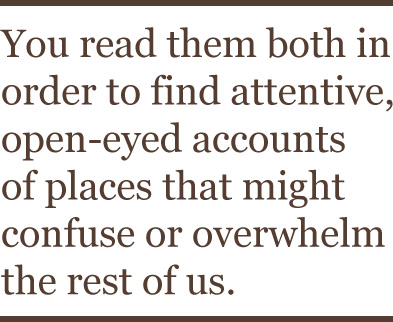 Such displays of judgment—both writers are the product of their age, and of the no-nonsense discriminations on which Britain built its empire (and which Naipaul uses as if to reconstruct it: none of the free-flowing, mixed-up minglings of Salman Rushdie for him)—take one away from the domain of philosophy and photography, but there is no denying the clarity, the sharpness of the observation of them both. Morris floods the canvas with opinions, enthusiasms, perceptions, but the effect is, finally, one of brilliant portraiture; Naipaul keeps out, cuts down, reduces everything to its lucid, almost Platonic essence, so as to create allegories of displacement and uprootedness. But you read them both in order to find attentive, open-eyed accounts of places that might confuse or overwhelm the rest of us, and it should be no surprise that their appraisals of societies (Australia as a “boom town without a boom,” in Morris’s words, India as a place where people “love to reduce the prosaic to the mystic”) are often not very far apart. There is an honesty to them both that is the backbone of judgment and that arises from a simple, frank determination to get to the bottom of places, to understand them truly.
Such displays of judgment—both writers are the product of their age, and of the no-nonsense discriminations on which Britain built its empire (and which Naipaul uses as if to reconstruct it: none of the free-flowing, mixed-up minglings of Salman Rushdie for him)—take one away from the domain of philosophy and photography, but there is no denying the clarity, the sharpness of the observation of them both. Morris floods the canvas with opinions, enthusiasms, perceptions, but the effect is, finally, one of brilliant portraiture; Naipaul keeps out, cuts down, reduces everything to its lucid, almost Platonic essence, so as to create allegories of displacement and uprootedness. But you read them both in order to find attentive, open-eyed accounts of places that might confuse or overwhelm the rest of us, and it should be no surprise that their appraisals of societies (Australia as a “boom town without a boom,” in Morris’s words, India as a place where people “love to reduce the prosaic to the mystic”) are often not very far apart. There is an honesty to them both that is the backbone of judgment and that arises from a simple, frank determination to get to the bottom of places, to understand them truly.
This means that, like all master portraitists, they depict the future as much as the past. It is obvious to see in both a deep commitment to history as guidebook, as talisman and cautionary tale, the text that reminds us of what happens to the new, and recalls to us a sense that our grand discoveries of today, our inventions, have been found a thousand times before; but what they are doing, deeper than that, is trying to locate that aspect of place which tells us what it will be tomorrow. Morris visits Baghdad after a coup in 1958 and tells us, in effect, of Iraq after the American invasion of 45 years later; she sees a “sugar and bikini state” in Cuba just after Fidel Castro’s takeover that applies perfectly to his slowly eroding country almost half a century on.
The tone, the music of their sentences, is always different; we see Naipaul, literally and figuratively, with head downturned, always close to breakdown. Morris holds her head up, unstoppable and undented, even when she crosses the boundary of gender, and emerges from a Casablanca clinic no longer a man but a woman. There is a sense of holiday about her writing, of imperial amusement (she cannot resist a footnote) that seems to belong to a different universe from the anguish and intensity of Naipaul, the single-minded focus that tells us that not a gesture of his is casual and he has made the investigation of these collapses his life’s work. Morris sympathizes with the stranded as Naipaul sometimes strains to do, because he is too terrified of becoming one of them. Writing is the only thing that allows him to step out from the crowds of mimic men, and to turn the chaos of the post-imperial experience into a kind of order. His clauses, his upright sentences cannot slip one inch; they are constructions built on the edge of a precipice, and if he lets down his guard, he seems to say, the whole edifice will come crumbling down, and back into the voice from which it came.
Morris is the optimist—“Youth, hope and silliness go together, in cities as in people,” she writes (revisiting Sydney), “and it is the hope that counts.” Like Naipaul, she describes herself in the places she sees—even India—but unlike Naipaul, she finds in most places a forgiving self (the outsider’s prerogative). There is, she writes, in India, a “kindly acceptance of things as they are, supported by the sensible thesis that things are not always what they appear to be.” She enjoys her golden period, with due irony, writing for Rolling Stone (the essays she writes for that cutting-edge home to scruffiness collected by Oxford University Press); she goes out from her hotel at dawn, far from the twilight, and the troubled darkness, that are Naipaul’s domain (and that he tries to bring into daylight with the lucidity of his prose). You could even find their stories in their names. James Morris became Jan without missing a stride, and even in the book she wrote about her sex-change operation, “Conundrum,” she confirmed one’s sense that, in the old imperial way, she would write about anything other than her self. Naipaul, in the style now old-fashioned, hides behind his initials, like a Victorian clergyman, even though his self is his central, essential topic, and his battle to put it on solid ground means that he would never explore another gender, and refuses ever to box himself into a community larger than one.
And yet, you come to see, in Morris’s final works—and this is the tendency of the writing all along—that she has chosen to wander and contemplate the last things of Empire because her life’s story, and her destiny, has been to be a pallbearer of sorts, a funeral singer of the kind you meet in Haiti. When her parents were born, two-thirds of the world map was colored pink; over the course of her adult life (since she came of age in 1944), she has seen one great possession of Empire after another fall away, into an independence that has not always been another word for self-sufficiency. Champion always of the mavericks and victims of Empire, the people along its sidelines, she has found herself, willy-nilly, the old order’s elegist, wandering around its battlefields to count the dead.
She sees, in Hong Kong and Singapore, a new order coming to light, built on a “sort of mystic materialism, a compelling marriage between principle and technique.” She speaks of “multiculturalism,” in the context of Toronto, long before most of the rest of us had heard the word (in 1983). And yet she ends her career, formally, with a book on Trieste, the nowhere place in between the great powers, taken up and then abandoned by them all at various times, as a way to ask difficult questions of herself, the order she was born to serve, and her very life as a chronicler of place. Oxford, she once wrote, “comes from the lost order of the English—essentially a patrician society, stable, tolerant, amateur, confident enough to embrace an infinite variety.” Just as one was noting how well she had found herself, again, in somewhere external to herself, one recalled that to look at Oxford, in her words, is to watch “the envoi to a majestic play.”
Naipaul is burdened with all he has inherited and, more acutely, with all that he hasn’t (a sense of order, a long tradition, a place where he belongs, inheritance itself). He has had to make himself up from scratch, he has often said, and writing is how he has done it, line by line, syllable by syllable. He is the person his books have made firm. And yet, looking at them both now, photographers-turned-philosophers, one sees, as they come towards the completion of their distinguished careers, where they look in the larger scheme of things: Morris delivering an elegant farewell as she waves a handkerchief from a great British vessel sailing out of sight; Naipaul telling us how we’ve ended up at the port, with nothing to replace it.
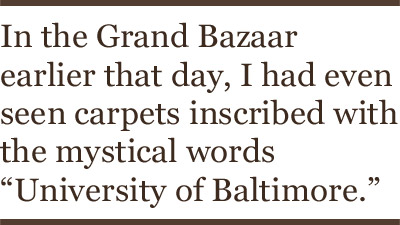 But still nothing had prepared me for the flash and glitter of it all. After I’d taken in Matthew McConaughey mumbling sweet nothings at the Citylife Cinema, I went across the street to the Sofa Hotel, and, setting foot in its elevator, found myself inside a kind of psychedelic light show, new colors coming through the transparent wall at every stop. When I started walking back toward the center of the city, I saw a woman in head-to-toe chador entering Starbucks to buy an espresso-flavored version of the jellied candy known as Turkish delight. In the Grand Bazaar earlier that day, I had even seen carpets inscribed with the mystical words “University of Baltimore.”
But still nothing had prepared me for the flash and glitter of it all. After I’d taken in Matthew McConaughey mumbling sweet nothings at the Citylife Cinema, I went across the street to the Sofa Hotel, and, setting foot in its elevator, found myself inside a kind of psychedelic light show, new colors coming through the transparent wall at every stop. When I started walking back toward the center of the city, I saw a woman in head-to-toe chador entering Starbucks to buy an espresso-flavored version of the jellied candy known as Turkish delight. In the Grand Bazaar earlier that day, I had even seen carpets inscribed with the mystical words “University of Baltimore.”


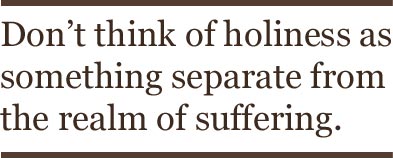 Even the girls, trained to be reserved and demure since birth, cannot contain their laughter—and delight, perhaps, and relief. Even this man regarded as an incarnation of a god by his followers is, at some level, just like them. Even he has been in need of discipline at times, and is in the lifelong business of finding an answer to suffering, or “Holy Pain,” as it might be. I scribble down his every word and notice how seamlessly he’s transmitting certain fundamental truths of Buddhism. Don’t be distracted by externals, or signs of ceremony—a yellow whip hurts just the same as any other whip. Don’t think of holiness as something separate from the realm of suffering—if anything, our most sacred duty comes in our response to the realm of suffering, which evolves through a change in perception. Don’t think of people as unequal—everyone has to go through the same lessons, and the Buddha himself, master democrat, gave us a sense of power and potential by always reminding us that he was no different from us.
Even the girls, trained to be reserved and demure since birth, cannot contain their laughter—and delight, perhaps, and relief. Even this man regarded as an incarnation of a god by his followers is, at some level, just like them. Even he has been in need of discipline at times, and is in the lifelong business of finding an answer to suffering, or “Holy Pain,” as it might be. I scribble down his every word and notice how seamlessly he’s transmitting certain fundamental truths of Buddhism. Don’t be distracted by externals, or signs of ceremony—a yellow whip hurts just the same as any other whip. Don’t think of holiness as something separate from the realm of suffering—if anything, our most sacred duty comes in our response to the realm of suffering, which evolves through a change in perception. Don’t think of people as unequal—everyone has to go through the same lessons, and the Buddha himself, master democrat, gave us a sense of power and potential by always reminding us that he was no different from us.




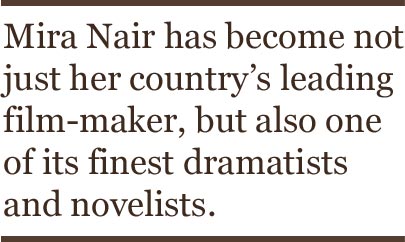 The first time I saw Monsoon Wedding was one day after I had left a large assembly of family and friends in Delhi, and its portrait of real life was so vividly real, and familiar in every particular, that I felt as if I’d never left Delhi at all. I recognized the cool global kids trying to slip away from their families, even as a fussing, anxious father was calling his youngers “idiots” and “fools” (and in one priceless coinage, “Number One Most Stupid Duffer”). Several languages were mingling in every sentence, so that even a two-word curse was sometimes polylingual–”Bloody feranghi,” (dutifully translated in the subtitles as “Bloody foreigner”). Here was all the laughing chaos, the delighted jostle of a country where phone connections suddenly go off in mid-phrase, the electricity flickers into darkness, a downpour threatens at every moment and nobody knows when anybody is coming (“10 min., exactly and approximately,” promises the slippery organizer in the opening moments). And as in any family reunion–in Poughkeepsie as much as New Delhi–the mood is that of a golden castle constructed, step by step, on thinnest ice, as befits the coming together of any people who know–and don’t know–each other too well. Which means that comedy, song-and-dance, romance and the outlines of tragedy also all flow in through Mira Nair’s wonderfully open door.
The first time I saw Monsoon Wedding was one day after I had left a large assembly of family and friends in Delhi, and its portrait of real life was so vividly real, and familiar in every particular, that I felt as if I’d never left Delhi at all. I recognized the cool global kids trying to slip away from their families, even as a fussing, anxious father was calling his youngers “idiots” and “fools” (and in one priceless coinage, “Number One Most Stupid Duffer”). Several languages were mingling in every sentence, so that even a two-word curse was sometimes polylingual–”Bloody feranghi,” (dutifully translated in the subtitles as “Bloody foreigner”). Here was all the laughing chaos, the delighted jostle of a country where phone connections suddenly go off in mid-phrase, the electricity flickers into darkness, a downpour threatens at every moment and nobody knows when anybody is coming (“10 min., exactly and approximately,” promises the slippery organizer in the opening moments). And as in any family reunion–in Poughkeepsie as much as New Delhi–the mood is that of a golden castle constructed, step by step, on thinnest ice, as befits the coming together of any people who know–and don’t know–each other too well. Which means that comedy, song-and-dance, romance and the outlines of tragedy also all flow in through Mira Nair’s wonderfully open door.